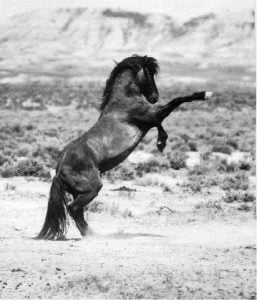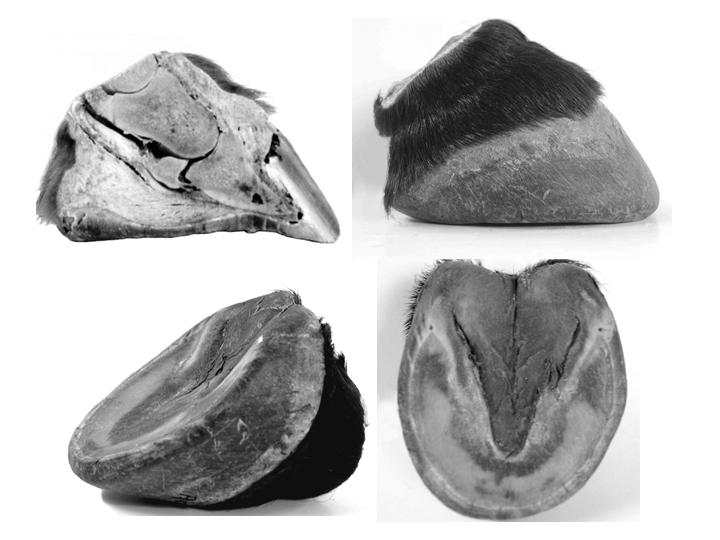Seems like a lot of people I know these days are keeping their horses barefoot (okay, maybe that’s because I’m getting selective about my horsey-friends), but when I first pulled my mare’s shoes six years ago, I was not exactly surrounded by supporters.
As a newcomer to the horse world, I had that indispensable naiveté that, though often disastrous, can occasionally expose a thread of common sense lost to those entrenched in tradition. Simply put, I didn’t “get” shoes. I thought, jeez, horses have gotten along just fine for oh, tens of thousands of years without ’em, what are we doing nailing iron onto their little feet for?? That line of questioning didn’t go over so well with the horse people I knew at the time. Horses need to wear shoes, they told me. That’s just how it is.
HMMMMM.
So, I took to the books. I found a local barefoot trimmer who was teaching workshops for horse owners wanting to trim their own horses, and that was that for the shoes Amalia had worn most of her life. We pulled them then and there at the workshop. Then, armed with naught but some messy notes (I’ve never been a good note-taker), several books and a stack of websites taller than me, a shiny new rasp and a knife with a wicked hook that made me feel very cool when sharpening it, I became the sole (sole! get it?) care-taker of eight needy hooves (two horses, four feet each, eight hooves, following me?).
Turns out the research (and oh god did I research) backed me and my naiveté right up (for once). Turns out, wild hooves have become the lynch-pin in modern hoof research, and the holy grail, the magnum opus we trimmers of domestic hooves can only dream of. Wild horses do, after all, traverse rocky terrain for many miles every day, remaining largely sound (certainly sounder than our languishing, laminitic domesticated equines) for most of their lives and all without human intervention. How? The earth shapes their feet. The earth, and their movement across it. The steady rhythms of wild hoofbeats pound and press and chip and grind that keratin into the shape that best suits the horses’ environment, locomotion, and diet. Oh! diet and feet… that’s another post all together.
FOR THE RECORD – let’s take a for the record break – yes some horses might benefit from wearing shoes in particular situations due to particular issues. I’m not going to get into that today. Just covering my own butt, here. Barefoot makes sense to me, but I am not a diehard purist. What’s best for the horse is, ultimately, what’s best for the horse! Back to our regular programming.
So what have I learned in my terrifying take-on of unimaginable responsibility? Way too much to write in any concise or prompt manner. Ha. I’ll give you some of what’s been on my mind lately.
One: OH my GOD just learn. I don’t care if you want to trim your own horses or if you never want to touch a rasp, you should still know the basics of how hooves work, what a healthy hoof should more or less look like, and how to know when you’re looking at unhealthy hooves. No hoof, no horse, simple as that. Knowing about feet also helps immeasurably when we’re talking about holistic horse care… they are a very important piece of this puzzle we call horse. I’m all about self-empowerment, and knowledge is power. If you’re well-informed, you will keep your hoof-care practitioner on their toes and ensure the best care you can for your horse. You will also quickly find yourself amazed and inspired by the complexity and incredible intelligence of the structure known as “foot”. Believe me, I was sketching hoof angles in the margins of Hobbes and Rousseau when I realized I needed to quit Western Philosophy…
Two: There is no such thing as natural anymore. “Owning” and managing horses is, inherently, unnatural. Everything we do affects them, and it all shows up in their feet. What we can do is (see number one) LEARN about what the horse’s biology is best suited for, and do our best to mimic the environment they need (a pale mockery of these conditions will do so much more good than no effort at all!) We may never achieve the “holy grail” of hooves in our horses, but dangnammit we can try! That said, we must always take into account the limits of every individual horse – heck, every individual hoof! My latest hoof-guru, Stefanie Travers, impresses the wisdom of the hoof. “Read the hoof,” she keeps telling me. “Wait. It knows what it needs.” Sounds a little arcane, but the more comfortable I get with feet, the more they speak to me. Basically, we should never force a foot to reach our intellectual ideals of “perfection”, simply because they are just that: intellectual ideals. Without conditions to support them since birth, our horses for the larger part are always going to be compromised. We can fight it, or we can accept it and move with it and turn it into something else.
Three: Let your knowledge evolve. Stay open and keep reading, both the articles and the hooves you come across. We live in a culture that seeks to nail things down, specialize, achieve expertise, win. We also live in a culture where knowledge is constantly evolving whether we ignore it or not. Pete Ramey says, “there’s no such thing as a good habit”, which essentially means that you should question everything that you do. What you think is right today may well prove to be wrong tomorrow. So it goes with hoof research. Nearly everything I have learned has eventually been proven wrong or at least incomplete, but at the end of the day (or the end of two to six weeks), feet have to be trimmed. So I go with what I know now, and hope like mad I haven’t done any harm, and go back to the experts and the books and have some tiny or enormous illumination that changes the way I approach the trim the next time.
Yeesh. Maybe it sound exhausting, but it’s actually kind of great. I’m not even touching on hoof pathologies, trimming techniques, or conflicting schools of thought, but maybe I’ll get to those eventually.
In the meantime, if I’ve piqued any interest (crickets?), two necessary reads for the aspiring hoof-nerd are Pete Ramey’s Making Natural Hoof Care Work for You, and Jaime Jackson’s Horse Owners Guide to Natural Hoof Care. Both provide enough background information and actual trimming know-how to get any horse-owner started trimming under the watchful eye of a cooperative professional.
UPDATE 21/07/2015: Since originally writing this article, I’ve been experimenting with Maureen Tierney’s work, a technique she calls the Hoof Guided Method. What I love about it is how simple it is, and how rigorous Ms. Tierney is about allowing the hoof to transform and heal itself, instead of forcing it into a preconceived notion of balance. She has lots of YouTube videos and an instructional DVD for sale.
I’m also really enjoying reading about the work done at Rockley Farm, a rehab centre in the UK that uses a 60 acre walking track (Paddock Paradise-style) and minimal, hoof-centred trimming to heal and rehabilitate horses with extreme dysfunction in their feet.
The adventure continues!
A barefoot hoof trimmer, a singer/songwriter, an amateur farmer – these are some of the hats Kesia Nagata wears when she’s not full to bursting with wondrous equine co-creation.









